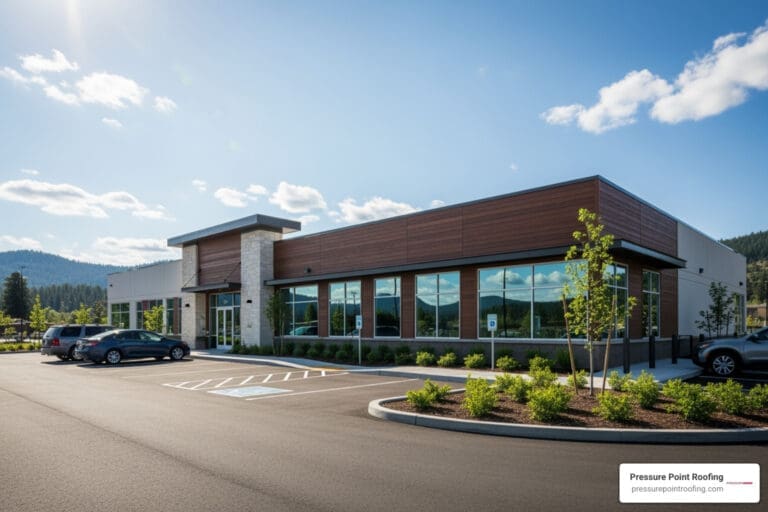Understanding the Costs of Roof Replacement and Repair
Replacing or repairing a roof is a significant investment for any homeowner. The price can often seem daunting, and estimates can vary widely, leaving many wondering why costs are higher than anticipated. We’ve compiled some information to demystify the elements that influence the cost of roofing projects, helping you understand what goes into a roofing estimate and why it might be more expensive than you initially thought. By understanding the costs of roof replacement and repair, you can feel more confident about your investment in your home.
 Common Factors Impacting the Costs of Roof Replacement and Repair
Common Factors Impacting the Costs of Roof Replacement and Repair
1. Type of Roofing Material
The choice of roofing material is one of the primary factors affecting the cost. Different materials have varying prices, lifespans, and installation complexities. Our Pressure Point Roofing experts can help you review your home and determine the best roofing material that fits within your budget. Common roofing materials include:
- Asphalt Shingles: The most popular choice due to their affordability and ease of installation.
- Metal Roofing: More durable and energy-efficient but comes at a higher price. This roof style has a longer lifespan than many other types of roofing material and can help protect your home from wildfire damage or destruction.
- Tile Roofing: Tile Roofing offers a distinctive look and excellent durability, especially in hot climates. It is one of the most costly options, however.
- Wood Shingles/Shakes: These provide a natural look but require more maintenance. Once a popular option in Oregon, fewer homeowners choose wood shingles because they have a shorter lifespan and are susceptible to fire embers.
- Slate Roofing: Known for its longevity and classic appearance, slate is one of the most expensive options.
2. Roof Size and Slope
It should come as no surprise that the size of your roof is directly proportional to the cost of replacement or repair. A larger roof requires more materials and labor, which increases the overall cost. However, the slope or pitch of the roof also affects the price. Steeper roofs are more challenging and time-consuming to work on, thus increasing labor costs.
3. Roof Complexity
The architectural design of your roof can also influence costs. Roofs with multiple chimneys, skylights, or valleys require more time and materials to ensure proper sealing and water drainage. Complex roof designs often result in higher labor and material costs.
4. Removal of Old Roof
The old one must be removed before a new roof can be installed. The cost of this removal can vary based on the number of layers that need to be stripped away and the disposal fees associated with the old roofing material. This can add a significant amount to the overall cost. Sometimes, the decking under a roof will also need to be replaced, adding to the costs of roof replacement.
5. Labor Costs
Labor costs can vary greatly depending on the region, the complexity of the job, and the roofing contractor’s experience and reputation. Skilled labor is essential for a quality roof installation or repair, but it comes at a price. On average, labor costs can make up about 60% of the total roofing cost. Differences in labor costs may make a difference, particularly if you compare a current estimate to what you paid for a roof replacement on a different home in another region or state.
6. Permits and Inspections
Roofing projects often require permits and inspections to comply with local building codes. The cost of permits can vary based on your location and the project’s scope. Additionally, some areas require multiple inspections during and after roofing, adding to the overall cost.
7. Unexpected Repairs
During the roofing process, contractors might discover underlying issues that need to be addressed, such as rotten decking, damaged insulation, or inadequate ventilation. These unexpected repairs can increase the overall cost of the project. Budgeting an additional 10-15% for these unforeseen expenses is wise.
8. Warranty and Insurance
A comprehensive warranty on materials and workmanship can add to the initial cost but offers peace of mind and protection against future issues. Additionally, ensuring that your roofing contractor is fully insured protects you from liability in case of accidents or damages during the project. While these factors add to the cost, they safeguard your investment.
9. Seasonal Considerations
The timing of your roofing project can impact the cost. Roofing is often more expensive during peak seasons when demand is high. Scheduling your project during the off-season might result in lower labor costs and shorter waiting times.
10. Energy Efficiency and Sustainability
Opting for energy-efficient or sustainable roofing materials can increase the initial cost but result in long-term savings on energy bills and potential tax credits. Cool roofs, solar panels, and green roofs are energy-efficient options that might have higher upfront costs but provide significant benefits over time.
Are you looking for a new roof or repairs to your current one? Start by contacting Pressure Point Roofing.
Understanding the various elements that influence the cost of roof replacement and repair can help you better anticipate and plan for this significant home improvement project. While the initial estimates might seem high, it’s important to consider the long-term benefits of quality materials, skilled labor, and proper installation. Investing in a durable and well-installed roof ensures your home’s safety, comfort, and value for years to come.
If you’re in the market for a new roof or need a reputable company to perform roofing repairs, start by contacting our professional team at Pressure Point Roofing. Pressure Point Roofing has been helping area businesses and homeowners maintain and improve their properties since 1989. We are one of the top-rated roofing contractors in Oregon and Northern California because we use only the best materials and are committed to training and safety. Contact us today for more information.
Schedule a Consultation
By submitting this form, I agree to receive calls and text messages (including those sent using automated technology) from Pressure Point Roofing, LLC and its representatives at the number provided. Message and data rates may apply. Message frequency may vary. Consent is not required as a condition of purchase. Reply STOP to unsubscribe at any time.
Related Content
Partners and Awards










 Common Factors Impacting the Costs of Roof Replacement and Repair
Common Factors Impacting the Costs of Roof Replacement and Repair

